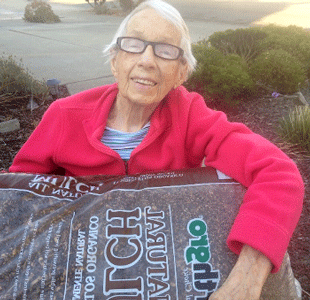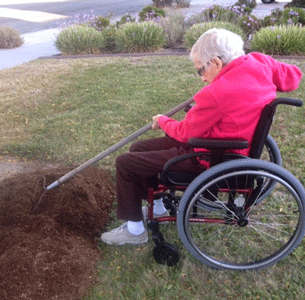Activities of daily living (ADLs) are the tasks we do during our daily lives. They are usually divided into two categories: basic ADLs and instrumental ADLs. Basic ADLs are the skills needed for eating, bathing, dressing, and toileting. Instrumental ADLs are the skills needed to function within society and within the community.
Person-Centered Care and Assistance with ADLs
Assistance with activities of daily living focuses on promoting independence and reducing the amount of help a caregiver must provide to the person needing assistance. Training, common sense, and appropriate assistive equipment are vital and can help the person you are caring for retain their independence as the dementia progresses.
Person-centered care, recognition of the perspectives of the person with dementia, and the creation of social environments that support well-being are important aspects of this type of care. Living with dementia involves enduring the loss of mental and physical abilities, which leads to difficulties in handling everyday living, maintaining meaningful activities, and taking part in social life. Because of the magnitude of its consequences, dementia-friendly or dementia-capable environments can help a person maintain independence in activities of daily living (Førsund et al., 2018).
For family caregivers, intimate knowledge of the preferences, likes, and dislikes of a family member is the basis for person-centered care. For professional caregivers, person-centered care means taking into account the opinions and concerns of the person with dementia as well acknowledging the contributions of family caregivers (Smebye & Kirkevold, 2013).
How to Assess if an Activity Is Meaningful
When caregivers understand how to provide meaningful activities that are matched to the abilities and interests of individuals with dementia, dramatic changes in agitation and reductions and improvement in overall symptoms can occur. In general, meaningful activities have these features (Mansbach et al., 2017):
- Active participation
- Activity content related to the interests and past roles of the participants
- Activities that meet the basic psychological needs of identity and belonging
Whether an activity is meaningful can be assessed using a tool such as the Engagement in Meaningful Activities Survey. This 12-item survey asks participants, “The activities I do”:
- Help me take care of myself
- Reflect the kind of person I am
- Express my creativity
- Help me achieve something that gives me a sense of accomplishment
- Contribute to my feeling competent
- Are valued by other people
- Help other people
- Give me pleasure
- Give me a feeling of control
- Has just the right amount of challenge
- Provide satisfaction
- Help me express my personal values (Eakman, 2012, Updated 2020)
Meaningful, Person-Centered Activities
People with dementia slowly lose the inability to create meaningful activities for themselves independently. To maintain quality of life and prevent development of behavioral symptoms, they must have the opportunity to continue to engage in activities that are adjusted to previous interests and the severity of their dementia (Volicer & van der Steen, 2014).
Meaningful activities should:
- Provide mental stimulation
- Reflect the past interests of the person with dementia
- Seek to maintain or slow the loss of skills without requiring the person to learn new ones
- Provide socialization, stimulation, and physical activity within the functional limits of the person with dementia
- Be sensitive to the cultural differences of those attending the activity
- Minimize failure (Zeman, 2015)


The author’s mother helping with gardening—an activity she had done her entire life. She could no longer walk safely but was eager to help in any way she could. Source: Author.
For dementia care staff, any contact with the person who has dementia is an opportunity for positive, meaningful interaction. Reminiscing, singing old songs, talking about shared interests, encouraging the client to help with minor chores, and breaking tasks down to allow the person to complete them, can all be enjoyable and stimulating activities and should be a regular part of the day (Zeman, 2015).
Supporting Independence in ADLs
In adult day programs, clients tend to need less assistance with ADLs than people in other long-term care settings, particularly with bathing, dressing, and toileting (Harris-Kojetin et al., 2016). In general, about one-third of day care clients need help with toileting, about a quarter need help with eating, and about a third need help with medication management. Nearly half need some assistance with walking and about a third need help with transfers (Dwyer et al., 2014).
Assistive equipment and environmental design can play an important role in supporting independence and reducing the amount of assistance required for ADLs. Equipment that is well-designed and readily available supports independence, while poorly designed equipment can reduce independence.
Familiarity also plays a role. In one example, Canadian researchers asked 27 older adults with mild, moderate, or severe dementia to test five faucet designs for ease of use. Although people with more severe dementia needed more help to turn the faucets on and off, all 3 groups needed more help with the less familiar design even though those faucets were considered to be better designed in terms of usability. The more familiar faucets correlated with lower levels of assistance from a caregiver, fewer operational errors, and greater operator satisfaction (Boger et al., 2013).

Faucets were ordered from least usable (left) to most usable (right) based on a human factors approach and most familiar (left) to least familiar (right) based on average years of exposure and commercial availability (Boger et al., 2013).
Routine and Structure in Adult Day Care
Often routines and schedules are related to the needs of staff or caregivers rather than the needs of the client. This is unfortunate because, for people with dementia consistent daily routines increase independence and can reduce the number and duration of challenging behaviors. A regular routine allows a person to know what to expect while giving caregivers a benchmark for evaluating a person’s behavior.
When developing a schedule for someone with dementia:
- Plan the schedule carefully.
- Consider each person’s capabilities and preferences.
- Try to continue familiar routines and schedules.
- Maintain mealtime routines.
- Maintain regular dental and healthcare appointments.
- Allow plenty of time.
- Note the effects of changes in routines.
- Consider issues that disrupt routines.
Although caregivers are responsible for maintaining a routine, they must be flexible and know when to make an adjustment. For example, if someone does not want to participate in an activity or eat at the scheduled time, it is best to be flexible and allow the person to rest or eat later.
